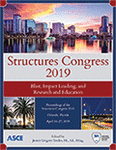Structures Congress 2019
Generation of Strut-and-Tie Models and Stress Fields for Structural Concrete
Publication: Structures Congress 2019: Blast, Impact Loading, and Research and Education
ABSTRACT
Strut-and-tie models are principally the discretized stress fields, which simplify the dimensioning and detailing of reinforced concrete members. The computational generation of stress fields currently relies on finite element analysis or optimization methods. This research addresses the limitations of optimization algorithms in producing reasonable strut-and-tie configurations. The computational procedure of this paper utilizes layout optimization and graphic statics cooperatively to create strut-and-tie models and stress fields for two-dimensional cases. The presented examples demonstrate the capabilities of the mentioned methods to produce some desired results for two-dimensional scenarios and suggest a similar approach to solve the strut-and-tie problem for three-dimensional cases.
Get full access to this article
View all available purchase options and get full access to this chapter.
REFERENCES
Ali, M. and White, R. (2001). “Automatic generation of truss model for optimal design of reinforced concrete structures.” Structural Journal, 98(4), 431–442.
Alic, V. and Persson, K. (2018). “Generating initial reinforcement layouts using graphic statics.” Proc., IASS Annual Symposia.
Beghini, L., Carrion, J., Beghini, A., Mazurek, A., and Baker, W. (2014). “Structural Optimization using Graphic Statics.” Structural and Multidisciplinary Optimization, 49(3), 351–366.
Bendsøe, M. P. and Kikuchi, N. (1988). “Generating optimal topologies in structural design using a homogenization method.” Computer Methods in Applied Mechanics and Engineering, 71(2), 197-224.
Bow, R. H. (1873). Economics of construction in relation to framed structures. Spon, London.
Culmann, K. (1864). Die Graphische Statik. Verlag Meyer und Zeller, Zürich.
Dorn, W. (1964). “Automatic design of optimal structures.” Journal de Mecanique, 3, 25–52.
Drucker, D. (1961). “On structural concrete and the theorems of limit analysis.” IABSE Publications, 21, 49–59.
Fleron, P. (1964). “Minimum weight of trusses.” Bygningsstatiske Meddelelser, 35(3), 81.
Kaufmann, W. (2018). Stahlbeton III. <http://www.kaufmann.ibk.ethz.ch/lehre/masterstudium/stahlbeton-iii.html>; (Oct. 15, 2018).
Lee, J., Van Mele, T., and Block, P. (2016). “Form-finding explorations through geometric transformations and modifications of force polyhedrons.” Proc., IASS Annual Symposia, 15, 1-10.
Liang, Q., Xie, Y., and Steven, G. (2000). “Topology optimization of strut-and-tie models in reinforced concrete structures using an evolutionary procedure.” ACI Structural Journal, 97(2), 322–332.
Mata-Falcón, J., Tran, D. T., Kaufmann, W., and Navrátil, J. (2018). “Computer-aided stress field analysis of discontinuity concrete regions.” Proc., Computational Modelling of Concrete and Concrete Structures (EURO-C 2018), 641-650.
Maxwell, J. (1864). “On reciprocal figures and diagrams of forces.” Philosophical Magazine and Journal Series, 4(27), 250–261.
McRobie, A. (2016). “Maxwell and Rankine reciprocal diagrams via Minkowski sums for two-dimensional and three-dimensional trusses under load.” International Journal of Space Structures, 31(2-4), 203–216.
Mörsch, E. (1906). Der Eisenbetonbau, seine Theorie und Anwendung. K. Wittwer, Stuttgart.
Muttoni, A., Fernández Ruiz, M., and Niketic, F. (2015). “Design versus assessment of concrete structures using stress fields and strut-and-tie models.” ACI Structural Journal, 112.
Nielsen, M., Braestrup, M., Jensen, B., and Bach, F. (1978). “Concrete plasticity, beam shear-shear in joints-punching shear.” Special Publication, Danish Society for Structural Science and Engineering, 1–129.
Neilsen, T., Akbarzadeh, M., and Goltermann, P. (2017). “Addressing buckling of compression members using subdivision of force diagrams.” Proc.,IASS Annual Symposia.
Python software foundation. Python Language Reference, version 2.7.13, (2016). <https://www.python.org/> (Oct. 15, 2018).
Ritter, W. (1899). “Die Bauweise Hennebique.” Schweizerische Bauzeitung, 33(7), 41–61.
Schlaich, J., Schäfer, K., and Jennewein, M. (1987). “Toward a consistent design of structural concrete.” Precast Concrete Institute (PCI) Journal, 32(3), 74–150.
Tabatabaie ghomi, A., Bolhassani, M., Nejur, A., and Akbarzadeh, M. (2018). “Effect of subdivision of force diagrams on the local buckling, load-path and material use of founded forms.” Proc., IASS Annual Symposia.
TopOpt plugin for Rhino and Grasshopper (2018). <http://www.topopt.mek.dtu.dk/Apps-and-software/TopOpt-plugin-for-Rhino-and-Grasshopper> (Nov. 12, 2018).
Van Mele, T. and Block, P. (2014). “Algebraic graph statics.” Computer-Aided Design, 53, 104–116.
Van Mele, T., Liew, A., Mendéz, T., and Rippmann, M. (2017). COMPAS: A framework for computational research in architecture and structures. <http://compas-dev.github.io/compas/> (Nov. 12, 2018).
Information & Authors
Information
Published In
Structures Congress 2019: Blast, Impact Loading, and Research and Education
Pages: 353 - 361
Editor: James Gregory Soules, McDermott International
ISBN (Online): 978-0-7844-8224-7
Copyright
© 2019 American Society of Civil Engineers.
History
Published online: Apr 22, 2019
Published in print: Apr 22, 2019
Authors
Metrics & Citations
Metrics
Citations
Download citation
If you have the appropriate software installed, you can download article citation data to the citation manager of your choice. Simply select your manager software from the list below and click Download.
